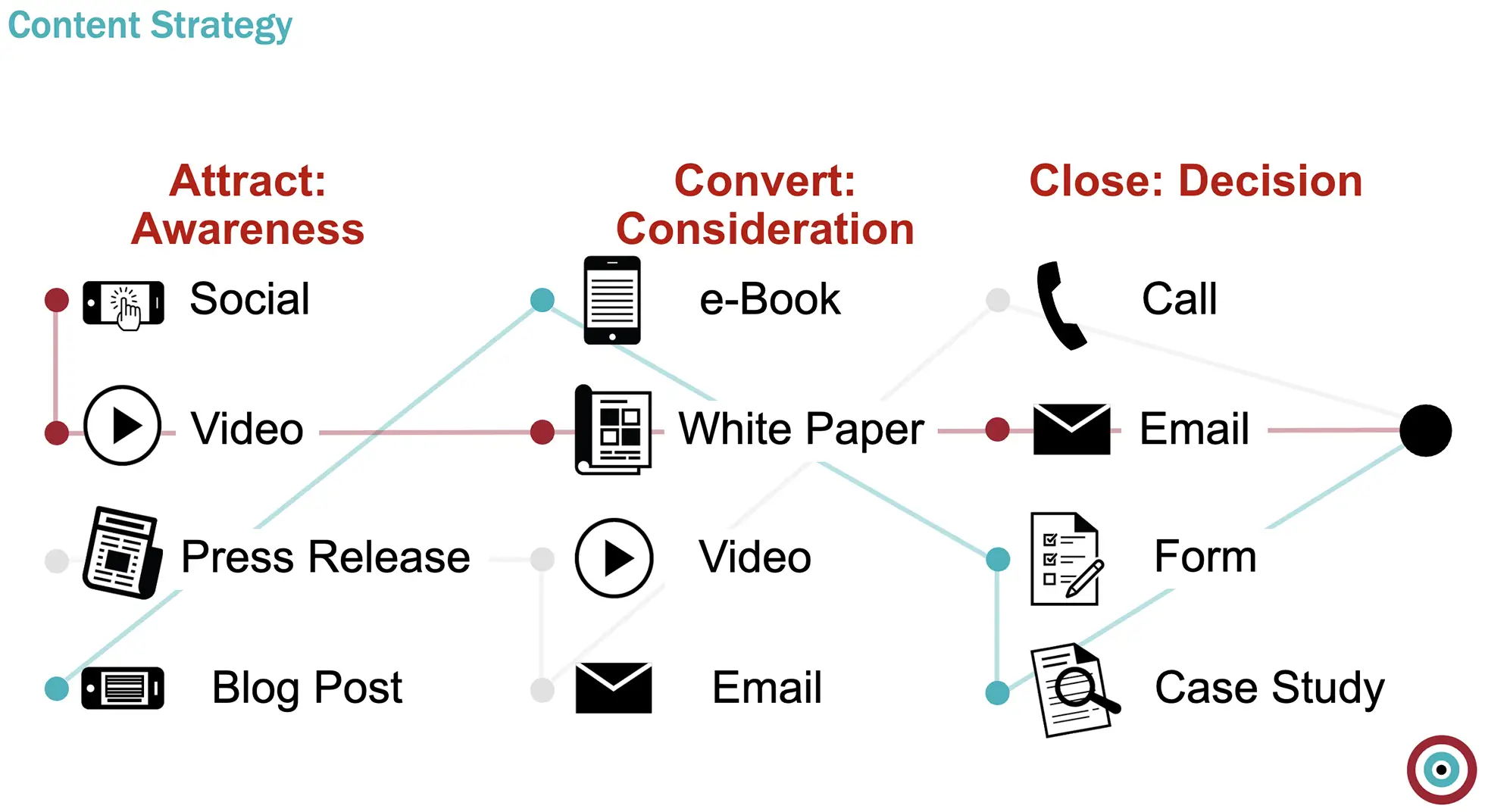Brand positioning serves as the foundation for your commercial efforts, allowing you to distill your value to your target market and build brand advocates. In our blog about the power of brand positioning, we discussed how to build a strong brand. Once you’ve accomplished this, how can you take the next steps to use that brand to guide your business decisions and grow your reach? Strategic marketing is the key.
What Is the Goal of Strategic Marketing?
If you’ve done the work to create strong brand positioning, you know who your target market is and what you want them to know. Strategic marketing translates that into a tailored, actionable plan to deliver that message to the right people, at the right time, through the most effective channel. There is no silver bullet or single channel that will allow you to accomplish this. To grow your reach and fill your pipeline, you need an integrated plan that considers both long- and short-term goals: a strategic marketing action plan, or as we refer to it at SCORR, a Strat MAP.
A successful marketing strategy is:
- Specific: You need to understand what the company’s business goals are and what marketing is responsible for achieving; from there you can build marketing goals, objectives, and strategies that ladder up to business goals
- Measurable: If you haven’t defined what success looks like in objective terms, you won’t know when/if you’ve achieved it or if you need to adjust your approach; to do this, identify key performance indicators (KPIs) that align with your specific goals
- Aligned: You need to ensure your marketing strategy is aligned with the other functions in the business, specifically commercial and operational functions; marketing and sales leaders need to be on the same page about roles & responsibilities and approach to drive pipeline
- Tip: Make sure your teams are using the same language (e.g., sales and marketing have the same definition of what a marketing qualified lead is)
- Scalable: Consider both short-term and long-term objectives. For example, many private equity or VC-backed organizations need to scale significantly on a three- to five-year timeline. In this case, you simultaneously strategize for converting demand to reach quarter goals and creating awareness to build the pipeline required to meet future goals
For examples of goals and metrics that drive value, check out SCORR’s client results.
Building the Foundation of Your Strategic Plan
The first step to planning ahead is looking back. Start with what you learned from the previous year: what tactics performed well, and which didn’t meet your expectations? This helps you determine where you are most likely to maximize your ROI. Also consider what channels you may have saturated and what channels you have more white space to continue to grow in.
From there, here are three questions you need to answer to build out the content for your marketing plan:
1. What kinds of content will communicate your message?
Content can be everything from long-form articles to videos to social media, and different kinds of content have different purposes. The content you release should work together to deliver information to your audience at different points in their sales journey, and each piece should be aligned with your overall goals and strategy. You should also think about any content you already have available, or which can be easily repurposed, to determine the pieces you will need to create.

2. Which channels will bring this message to your audience?
You know from your brand positioning who your audience is and what they care about. You can use this information to determine which channels will deliver your message to these individuals. Consider how they gather information, what trade publications they read, what events they attend, etc. Remember to think through how you will reach both decision-makers and influencers involved in the buying decision of your solution. A robust plan will cover trade media, events, digital, and public relations, and will tailor your content and message to each channel to best influence your target audience at the most strategic time.
3. Is your content aligned across functional teams?
Collaborate with your organization’s product/operational and sales leaders to ensure your content and promotional schedule. Make sure you know what advancements, adaptations, or new launches are on the horizon. This helps set your sales team up for success with content that accurately reflects the most up-to-date information and benefits.
Putting Your Plan Into Action
At this point, you have outlined your objectives and which tactics will help you achieve them. The next step is laying that out over a timeline that specifies exactly when and how you will distribute your content. And most importantly, what you expect to achieve by strategy (via KPIs) and in what time frame.
Part of your responsibility as a marketing leader is to effectively share your plan with internal stakeholders and ensure each team understands their role and the reasoning behind the plan as it relates to their department. Make sure your sales team knows how you will support them in the coming year, your product team knows how you plan to promote upcoming launches, and your finance team knows why you are investing in the tactics you have selected. Building this understanding of why the channels/tactics in your plan were chosen — and why others weren’t — keeps everyone on the same page.
Next, you’ll need to allocate your resources to execute your strategic plan. Resourcing is all about the specifics of how you will deliver on your plan most effectively. Make sure the thought leaders you are promoting are ready and able to dedicate time to content development. Consider which parts of the plan you will have in-house resources execute and which it may make sense to outsource to an agency.
Monitoring and Adjusting Strategies
Gathering data is critical to strategic decision-making. You’ve already done the work to determine the metrics you will use to measure your success, so now you need to monitor those metrics efficiently and use that information to adjust as necessary.
Set a cadence to share marketing data with internal stakeholders. During these meetings, the goal is to articulate what the data you have collected mean and how you will adjust your plan accordingly. Your stakeholders need to know if you are on track with, behind, or ahead of the plan, and how this impacts marketing activities. Depending on the metrics, you may need to shift, increase, or decrease your investment.
In addition, have a plan to collect and analyze market feedback and consumer behavior. Collaboration between your business development and marketing teams is essential to enabling this effort. You can also follow key publications/editors and conduct ongoing client satisfaction and lost opportunity surveys to keep a pulse on your clients and the larger competitive landscape. This information allows you to identify opportunities and address potential challenges.
Throughout the process of monitoring your results, be flexible. If your business strategy is changing, your marketing NEEDS to change. The purpose of a strategic marketing plan isn’t to have one strict approach, but instead, to guide your path and keep your marketing plan aligned with business goals. However, keep in mind that any changes you make need to be backed by data and strategy. This means knowing how long you need to run a program to measure its success, so you don’t cut it prematurely — and making sure your teams know this as well. Remember that once your internal team feels like you’re repeating your message, your market is likely just starting to understand it.
Ready to Build Your Marketing Plan?
In today’s dynamic market, using strategy and data to guide your efforts helps you stay competitive. When done well, your strategic marketing plan enables sustainable growth. If you’re ready to put your messaging into practice, build awareness, and drive ROI, a strategic marketing plan is the place to start.
For more information on marketing strategy, explore our resources or contact us to build a personalized plan.

